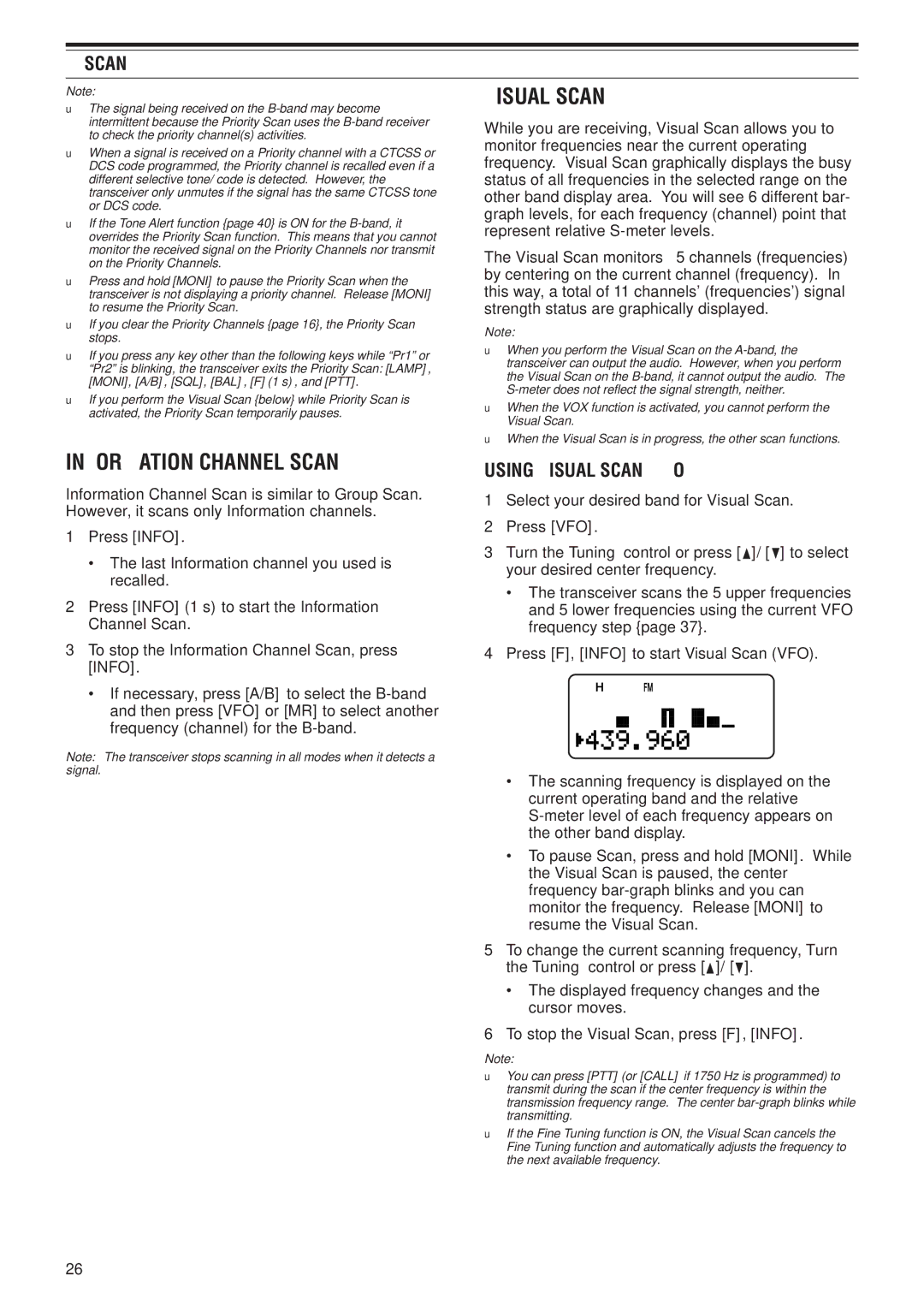
7 SCAN
Note:
◆The signal being received on the
◆When a signal is received on a Priority channel with a CTCSS or DCS code programmed, the Priority channel is recalled even if a different selective tone/ code is detected. However, the transceiver only unmutes if the signal has the same CTCSS tone or DCS code.
◆If the Tone Alert function {page 40} is ON for the
◆Press and hold [MONI] to pause the Priority Scan when the transceiver is not displaying a priority channel. Release [MONI] to resume the Priority Scan.
◆If you clear the Priority Channels {page 16}, the Priority Scan stops.
◆If you press any key other than the following keys while “Pr1” or “Pr2” is blinking, the transceiver exits the Priority Scan: [LAMP], [MONI], [A/B], [SQL], [BAL], [F] (1 s), and [PTT].
◆If you perform the Visual Scan {below} while Priority Scan is activated, the Priority Scan temporarily pauses.
INFORMATION CHANNEL SCAN
Information Channel Scan is similar to Group Scan. However, it scans only Information channels.
1Press [INFO].
•The last Information channel you used is recalled.
2Press [INFO] (1 s) to start the Information Channel Scan.
3To stop the Information Channel Scan, press [INFO].
•If necessary, press [A/B] to select the
Note: The transceiver stops scanning in all modes when it detects a signal.
VISUAL SCAN
While you are receiving, Visual Scan allows you to monitor frequencies near the current operating frequency. Visual Scan graphically displays the busy status of all frequencies in the selected range on the other band display area. You will see 6 different bar- graph levels, for each frequency (channel) point that represent relative
The Visual Scan monitors ±5 channels (frequencies) by centering on the current channel (frequency). In this way, a total of 11 channels’ (frequencies’) signal strength status are graphically displayed.
Note:
◆When you perform the Visual Scan on the
◆When the VOX function is activated, you cannot perform the Visual Scan.
◆When the Visual Scan is in progress, the other scan functions.
USING VISUAL SCAN (VFO)
1Select your desired band for Visual Scan.
2Press [VFO].
3Turn the Tuning control or press [![]() ]/ [
]/ [![]() ] to select your desired center frequency.
] to select your desired center frequency.
•The transceiver scans the 5 upper frequencies and 5 lower frequencies using the current VFO frequency step {page 37}.
4Press [F], [INFO] to start Visual Scan (VFO).
•The scanning frequency is displayed on the current operating band and the relative
•To pause Scan, press and hold [MONI]. While the Visual Scan is paused, the center frequency
5To change the current scanning frequency, Turn the Tuning control or press [![]() ]/ [
]/ [![]() ].
].
•The displayed frequency changes and the cursor moves.
6To stop the Visual Scan, press [F], [INFO].
Note:
◆You can press [PTT] (or [CALL] if 1750 Hz is programmed) to transmit during the scan if the center frequency is within the transmission frequency range. The center
◆If the Fine Tuning function is ON, the Visual Scan cancels the Fine Tuning function and automatically adjusts the frequency to the next available frequency.
26
